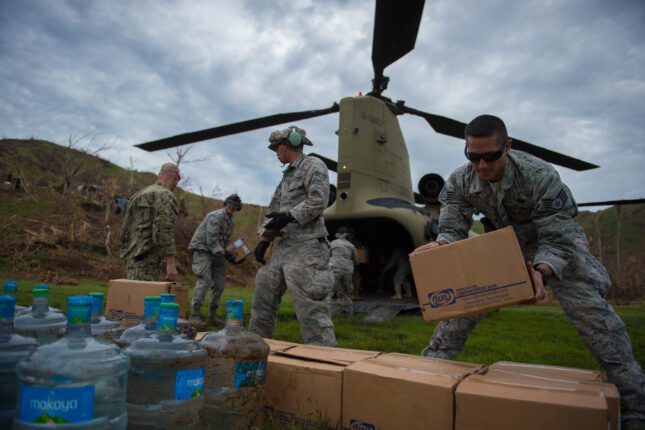-
The US Department of Defense’s Role in Integrating Climate Change into Security Planning

The recent floods and landslides in Brazil, displacing almost 100,000 and killing at least 100, reminds us that climate change-fueled extreme weather, combined with an intense El Niño, is a deadly combination. Governor Eduardo Leite of the southern Brazilian province, Rio Grande du Sol, described the devastation the region was subjected to as “unprecedented.” As President Luiz Inacio Lula da Silva noted: “We need to stop running behind disasters. We need to see in advance what calamities might happen and we need to work.”
How should the US government integrate these climate change concerns into its defense and security planning? More specifically, what roles should the Department of Defense (DoD) play in this overall effort, and how should DoD integrate within the overall government effort?
Currently, DoD is leading in three important ways: 1) working with allies and partners; 2) making bases and infrastructure more climate resilient; and 3) reducing energy vulnerabilities and assuring energy resilience through decarbonization.
DoD certainly does not, and should not, take the lead in US government responsibility for the vast array of global security, development, environmental, and diplomatic challenges created by climate change. However, if DoD takes a proactive, preventative approach to address multidimensional security risks, it will reduce climate-related strains to military infrastructure, capabilities, and missions. This approach will also enable the nation’s largest energy user to lead by example in the energy transitions essential to addressing climate change and its impacts.
Redefining Climate Risk
Today, DoD is placing greater emphasis on co-creating strategies with partners that look further upstream and integrate development and governance concerns. This approach considers how US partners compare risky tradeoffs and consider how decisions align with available government resources, capabilities, and expertise. As an example of this evolving understanding, an overriding focus on humanitarian assistance and disaster response (HA/DR), while vitally important in times of crisis, carries the potential to exacerbate those short-term needs over time if more preventative longer-run development priorities are not considered in tandem. In this vein, DoD’s efforts to share its Defense Climate Assessment Tool (DCAT) and other climate exposure mapping tools with allies and partners is an important step to support partners in decarbonizing and building resilience within their own critical infrastructure.
A key aspect of these immediate DoD efforts is that if lasting climate-resilient development is US-funded, it often requires a greater initial investment, and/or is more onerous, than Chinese-funded projects due to US government requirements for environmental impact assessments and adherence to governance or transparency requirements. Larger megaprojects that often carry adverse environmental and social impacts, such as forced displacement, are more likely to be greenlit by Chinese development banks than US-affiliated funding mechanisms. Currently, there are many signs that Chinese investment in Latin America is diversifying away from earlier extractive megaprojects to smaller, more frequent investments in strategic sectors such as aerospace and information and communications technology (ICT). The government, and DoD in particular, should move away from viewing development projects through either a macro lens of geopolitical competition or a domestic political lens to score electoral points while undercutting long-term fiscal and environmental considerations. Rather, the US government should think strategically about how it can best enhance countries’ own development visions with projects that fit long-run, inclusive, and sustainable growth trajectories.
As part of the interagency effort on climate security, the government should explore supporting partner nation development strategies by expanding the umbrella of what is considered critical infrastructure for desired development projects in urban, rural, and coastal settings. DoD, in conjunction with its allies’ and partners’ defense and security agencies, should think creatively about how to collaborate with interagency partners and make use of its resources and technical capacities in a supporting role, especially as long as USAID-led development efforts remain chronically unfunded and underappreciated by Congress.
If drought in rural areas induces rapid and informal urbanization patterns, for example, and then a severe weather event creates significant volatility that leads to mobility pressures (which occurred with Hurricanes Eta and Iota in Guatemala and Honduras), an already vital and difficult development challenge takes on additional importance for national security. Investing proactively in this multilayered risk reduction, hazard preparedness, and climate resilience efforts should be considered not only as development priorities but also as national security priorities. They should be funded and supported accordingly.
In parallel with infrastructure, the current situation in the Darién Gap, a narrow geographical chokepoint between Panama and Colombia, is an example of the need to consider climate change as a driver of security risks. The Darién, long considered one of the most dangerous land corridors in the world due to its challenging topography and presence of transnational criminal organizations (TCOs)—namely gangs and drug cartels—has seen the number of US-bound migrants passing through its jungles skyrocket in recent years. As the route through the Darién has become more accessible, it has created a booming black market for TCOs to exploit rising demand, with horrifying declines in humanitarian protection. As climate change continues to strain countries in Latin America and increase the push factors for the wide range of mobility patterns—towards the United States, within countries, and for involuntarily immobile populations—DoD has seen an increased demand on US forces, along with partner militaries, for actions and support to reduce the most severe impacts of malign actors, respond to the immense pressure regional governments face, and help increase humanitarian protection for vulnerable populations.
The US government’s climate-security interagency process should strengthen mechanisms for interlinking various agencies’ strategies through planning, budget development, and execution. An immediate priority is to integrate DoD authorities and funding in support of these broader agendas. In particular, bolstering partner nations’ armed forces’ HA/DR capacities can provide support during climate shocks and extreme weather events, and protecting installations and critical infrastructure can enable broader economic growth.
Some examples to explore further could include supporting wider infrastructure development near installations or expanding the scope of HA/DR to include not just immediate disaster response but also longer-term support for reconstruction that reduces risks of illegal activities, such as illicit mining, deforestation, and illegal, unregulated, and unreported (IUU) fishing.
State capacity and security are needed to protect forests, other terrestrial natural systems, healthy marine ecosystems, the carbon sequestration functions of these ecosystems, and the sustainable livelihoods they support. Inter-linked and coordinated climate security strategies among the State Department, DoD, USAID, and other government entities, along with the coordinated implementation of those strategies at the planning, budgeting, and execution levels, can and should be leveraged as an integrated national security prerogative for advancing these outcomes. Both the Executive Branch and Congress should identify statutory, fiscal, and other types of barriers to developing and implementing such an integrated strategy and take steps to eliminate them.
With ambitious thinking and emphases on human security investments and co-creating strategic planning with partners, the US government can serve as a partner of choice by supporting comprehensive, integrated development and security agendas. In this way, DoD and other government agencies can enhance the 2022 National Security Strategy’s call to “increase cooperation and support to trusted partners, shifting from a strategy that is ‘US-led, partner-enabled’ to one that is ‘partner-led, US-enabled.’”
Sherri Goodman is Secretary General of the International Military Council on Climate and Security and a Senior Fellow at the Woodrow Wilson International Center. She was the first US Deputy Undersecretary of Defense for Environmental Security. Her book, Threat Multiplier: Climate, Military Leadership and the Fight for Global Security, will be published in 2024.
Max Nathanson is the inaugural Fellow for Climate Security Studies at the William J. Perry Center for Hemispheric Defense Studies, the US Department of Defense Regional Center for Latin America and the Caribbean. He is also a doctoral candidate at the University of Oxford’s Smith School of Enterprise and Environment.
The authors are grateful for input from Brigadier General J. Robert “Bob” Barnes, US Army (retired), Senior Policy Advisor and member of the Advisory Board at the Center for Climate and Security.
The views expressed in this article are those of the authors and do not reflect the official policy or position of the National Defense University, the Department of Defense, or the US government.
Sources: Al Jazeera
Photo credit: U.S. service members stack boxes of aid which and water while off loading a U.S. Army CH-47 Chinook during an aid relief mission in Anse d’Hainault, Haiti in 2016, courtesy of Staff Sgt. Paul Labbe/U.S. Air Force.
 A Publication of the Stimson Center.
A Publication of the Stimson Center.






